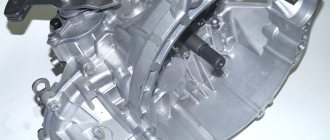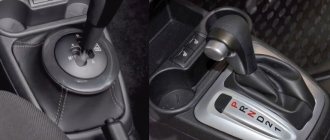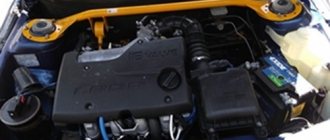In search of methods to reduce the cost of cars, corporations today are ready to take the most unpredictable steps. AvtoVAZ is ahead of the curve in trying to make the production of its cars inexpensive in order to somehow cope with the financial hole and keep the price tags for vehicles within a reasonable range. The company is succeeding with difficulty, but so far things are going well in this area. Especially when it comes to cheaper prices. So, on the new generation of cars, instead of a simple Japanese automatic, AvtoVAZ offered its own development - the AMT robotic gearbox. This robot became the first automatic transmission developed in Russia, which was launched into series and successfully implemented. But by the word “successful” we mean the success of selling a car with such a unit for the factory. For the buyer, there was nothing particularly successful in buying the first generation of this very robot. Already at 40,000 km, almost all car owners contacted the service, many several times.
The concern decided to correct the situation, and with a small update of Vesta, it installed robot 2.0. This is exactly what Russian marketers from the AvtoVAZ plant called their creation. Let's see if marketers designed this box. By the way, so far the reviews about the second generation of the robot are really better than the first. This leads to one positive thought - AvtoVAZ has become a learner and at least a little monitors the feedback from its customers. By the way, this is also shown by some of the improvements that the concern has made to its cars in recent years. But let’s return to AMT and continue the conversation on this topic. The robotic box was modified by engineers from Russia, Germany and Romania. It has a more reliable design; parts that previously failed too often have been eliminated. We had to slightly increase the total cost of the design, but the result is there, and that’s already good.
Main changes - first impressions of robot 2.0
Let’s say right away that AvtoVAZ this time did not promote itself by updating such an important component in the car; many buyers did not even know that the Vestas being picked up from the showroom already had a completely different unit under the hood. The engine remained the same, but the gearbox received more than 100 small and medium-sized corrections, so it would be hard to call it the same. After a test drive and a comparative ride in a car with an old robot, we can draw the first conclusions:
- AMT 2.0 works much more pleasantly, and this can be seen from the first kilometers of the trip. Soft shifts, no jerking, precise prediction of driver actions and an intelligent control system.
- A creeping mode has appeared. This means that the robot reacts to releasing the brake pedal like a real automatic machine. The car begins to move a little or stands motionless on the hill. Such a system was sorely missed.
- The selector's previous characteristics remained, but it began to feel somehow more reliable and convenient. It was as if I was sitting not behind the wheel of a Lada, but in the cabin of a Toyota or Volkswagen.
- The robot began to work noticeably more quickly, it reduced the time it took to complete the full phase of gear engagement by 30%, and this clearly benefited the dynamics of the car and the sensations of the trip.
- Many of the shortcomings have been corrected, which means that you don’t have to worry about whether the unit will withstand a particular load or cope with certain climatic conditions.
The winter mode remains, but its characteristics have changed slightly. Now the car owner can forcefully engage second gear using the selector. True, you need to do this every time you start. But in the previous version of the robotic gearbox it was not possible to start from second gear to overcome the challenges of winter roads. This makes the box happy; it has become more adapted for Russian operating conditions. So there are practically no disadvantages with the first acquaintance.
Read more about crawling mode and its features
The so-called Creeping Mode was a real revolution for this type of gearbox, and in Russia it was not expected from domestic cars. This completely changes the perception of car operation and brings incredible pleasure from the trip. But if you go into the theory a little, you will begin to be a little surprised. At AvtoVAZ, this mode is implemented directly in the box, like on automatic machines. This is very expensive, and there are suspicions that such a system may fail.
The nuances of this creeping mode are as follows:
- the torque in Creeping Mode will be quite high, even on a hill the car most often starts to move rather than stand still, as in most other robotic gearboxes;
- the load on the clutch is crazy, and one can only guess what the service life of this unit will be on this gearbox; now, under warranty, everyone will change the clutch several times in 3 years;
- the mode does not allow you to roll back, and this is very unusual for those who have switched from any other robot, this unit operates solely according to an algorithm, without taking into account the actions of the driver;
- if you release the brake on a hill and sharply give the gas, the clutch will slip and the mechanism will suffer terrible wear, after several such starts you can prepare to replace the clutch;
- the design has become more expensive, but the car is gone, we can conclude that AvtoVAZ saved on something else in order to reach a financial balance, and for now we can only guess about the subject of savings.
By the way, one of the most important changes in robot 2.0 was the firmware. The official dealer stated that all interested car owners with the first generation of the robot can install the new firmware from official dealers. True, this statement was quiet and not too bold. And rightly so, since in the second generation of the robot there were many changes in technology. Installing the firmware separately from these changes will not always be a good idea.
Advantages and disadvantages of the “automatic machine”
If we talk about the advantages of automatic systems, they include:
- Easier and simpler controls.
- Reduced load on the engine (this advantage becomes more obvious when compared with a manual transmission, where more engine revolutions are required to change speed).
- Reduced loads on the chassis of the car.
The disadvantages include:
- Higher fuel consumption.
- Poor acceleration dynamics (when compared with manual transmission).
- Reduced efficiency.
- Higher oil consumption.
- Slow gear changes.
- There is a risk of the car rolling away if the car is on a slope.
Thus, an automatic transmission is in many ways better than a manual transmission, but the robotic system is actively stepping on the heels of the automatic transmission.
Technical shortcomings - how else can you criticize Robot 2.0?
A small database of reviews about the second generation of the robotic box has already been collected. The first clutches have already fallen off, so be careful with this creeping mode. But that's not the worst thing. You just need to get used to the behavior of the box and understand how it should be operated without putting unnecessary stress on the main parts. Otherwise, there are still a lot of shortcomings that will apparently be eliminated in robot 3.0. I wonder if AvtoVAZ specifically left these shortcomings so that there would be something to work on further?
There are several general disadvantages of the new gearbox:
- the kick between first and second gears remains, before it was a failure, but now it’s a kick, but the discomfort from this change has not become less, there is a desire to drop the gas pedal;
- the reverse gear is engaged inadequately, the car is already rolling, and at this time the driver feels a noticeable blow, as if on an old Japanese automatic machine that requires major repairs;
- the creep mode in first gear is very aggressive, and this not only constantly affects the clutch, but also wears out your pads, since you have to constantly brake;
- the design of the unit may not be the best, since the assembly is Russian, so precise mechanisms and parts of foreign design may not take root in a domestic device;
- it is not entirely clear whether the device will withstand the loads placed on it; it seems that Vesta is too heavy and large for this gearbox, and this feeling is only getting stronger.
Maybe such a robot will behave perfectly on Grants. It is quite possible that there we will not pay attention to his quirks at all. But Vesta is the flagship of the corporation, and the buyer has more complaints about its quality of operation. And so far the machine does not behave very adequately with the robot. It is much easier to buy simple mechanics and drive a car without problems and troubles. And the service life of a manual transmission will be much higher than that of a robotic one. There can be no debate on this issue.
Why was a robot needed at all?
AvtoVAZ strives to be in trend and follows global trends. This was the answer to this question from the company's management at all major press conferences. But in fact, everyone understands that Lada developed its “own” robot far from wanting to be in trend. The company created a gearbox that would replace the Japanese Aisin automatic, which turned out to be too expensive after the ruble exchange rate jumped. This is a banal saving, which today leads to increased costs of money on the part of car buyers.
There are several real factors that influenced the appearance of the robot as a whole:
- an increase in the price of the machine gun, since the company bought it in dollars and installed it on assembled cars; the Japanese assembled the machine guns and ensured a very high quality of their design;
- the four-speed automatic no longer looked modern, something more relevant, dynamic and fashionable was needed, which was the solution for the robot with its interesting design;
- it was necessary to come up with something Russian so that domestic cars would become more their own, less dependent on currency fluctuations and other unpleasant economic effects;
- this way the company concentrated more financial flows in its hands, was able to invest more money in its own developments and benefit financially in the end from all innovations;
- it is necessary to somehow improve the image of the corporation, and the new development came in handy to improve the perception of AvtoVAZ on the Russian market, as well as to enter the markets of other countries.
These are the multifaceted reasons for the introduction of this new product, from which ordinary buyers did not benefit, but the plant benefited. Of course, it would be better to have an Aisin automatic under the hood, which will last longer than the domestic engine. But Lada is still promoting its own development, which costs much less. Therefore, there is no point in hoping for major improvements in technology in the near future. You'll have to get used to the robot or just take the mechanics and not know grief with it.
We invite you to watch a video review of the features of the machine with robot 2.0:
Lada Vesta and manual transmission: five reasons to buy for and four against
A certain part of motorists continue to ignore the achievements of transmission cybernetics and choose cars with a manual transmission. If we analyze their arguments, we can formulate five main reasons based on which it is worth considering this option:
- Affordable price - the basic model costs 509,000 rubles, for the robot you need to add 25,000 rubles. If you take a car with a manual transmission, then for the money you can get a higher level of equipment. A new AMT robot unit from a dealer costs 56,200 rubles, plus about 10,000 more for installation, so if something happens, the amount for repairs is quite impressive, which cannot be said about a manual gearbox.
- Full configurations – for models with manual transmission there is no discrimination in terms of configurations. If you want a “full stuffing” of a car, that’s not a question, and it’s not necessary to take a robot because of the additional options.
- Pleasant dynamics - according to documents, a car with a manual transmission accelerates to 100 km/h 1 second earlier than its automatic counterpart. In practice, this is significant time, which does not allow you to sweat when overtaking.
- Reliability - according to reviews and tests of the Lada Vesta, the mechanics did not give any particular cause for alarm, especially since in case of repairs the costs will be significantly lower.
- Potential liquidity - after a certain time, selling a car with a manual transmission on the secondary market will be much easier.
Let's sum it up
Modern generation cars from AvtoVAZ have become much better than the previous ones, but buyers want even more progress and pleasant updates from the Russian concern. While buyers complain about high prices, Lada is actively saving on everything it can save on, and is also experiencing constant financial difficulties. It's amazing how you can sell so many cars and still struggle with money. The VAZ plant has always succeeded in this and continues old traditions with pleasure. But irony aside, Robot 2.0 turned out to be one of the concern’s best technical developments.
At least the company is trying to do something with the unit and improve it. Today, this technology provides certain additional capabilities to the driver, drives well, and copes well with difficult Russian travel conditions. Also, the robotic box can be slightly modified for installation on elevated versions of the Cross. Most likely, the robot will get a slightly smoother ride in first gear in crawling mode as an update, which will improve the clutch life and reduce discomfort for the driver in the process of getting used to the car. Did you like the characteristics of the new robot from AvtoVAZ?
Lada Vesta SV Cross AMT - how did it appear?
The AMT on the Lada Vesta SV is a unit already familiar to us, which has already appeared on other domestic models - Lada Priora, Granta, Kalina, X-ray. At first there were rumors that this same robot was developed by engineers from Renault-Nissan, but later these rumors were refuted. The AMT Lada Vesta SV Cross itself is AvtoVAZ’s own development.
In recent 2015, under the leadership of Vladimir Petunin, the first serial robot was developed. The basis was the usual 5-speed VAZ manual transmission 2180, which is already familiar to everyone. ZF electric actuators of German origin were used as the actuator. They are responsible for pressing the clutch and selecting gear for the driver. A shaft speed sensor also appeared at the gearbox. All together gave a robotic gearbox with the VAZ-2182 index:
Gear shift actuator for Lada Vesta SV Cross AMT
The actuator mechanism for selecting and switching speeds on the AMT Lada Vesta SV Cross looks like this:
1 — Gear selection drive 2 — Electric motor 3 — Gear selection drive 4 — Electric motor 5 — Gear selection rod
Actuators (electric motors) are used from German ZF.











